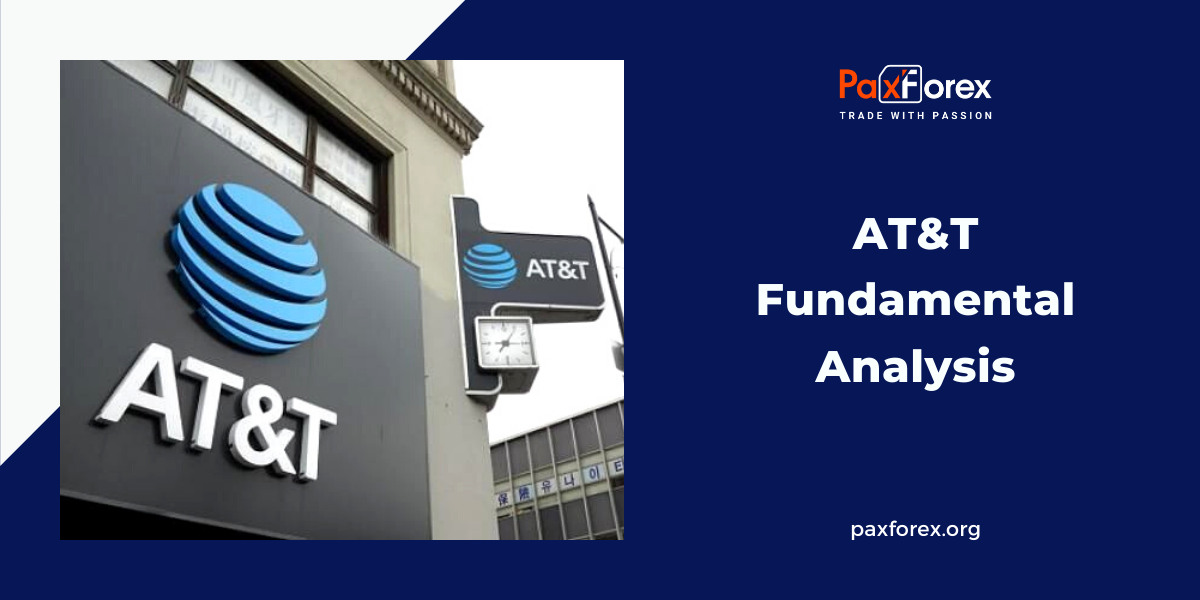
Source: PaxForex Premium Analytics Portal, Fundamental Insight
The performance of AT&T stock this year has sharply contrasted with the broader market's performance. While the S&P 500 has shown a year-to-date increase of approximately 10%, AT&T's shares have plummeted by roughly 20%.
Several factors contribute to this pessimistic sentiment. The wireless industry has experienced a slowdown this year, partly due to a hangover effect from the strong growth seen during the pandemic and partly due to economic uncertainty. During the second quarter, AT&T added just over 300,000 net postpaid phone subscribers, which is less than half of what it was adding each quarter throughout much of 2021 and 2022.
Given that AT&T stock lags significantly behind the broader market, and with the wireless industry becoming increasingly competitive, it's understandable that many investors have written off the telecom giant altogether. However, there is one compelling reason to seriously consider investing in this stock.
While a company's growth prospects are essential, they are only one part of the equation. It's true that AT&T is likely to face a slower growth environment in the coming years compared to the past few years. Consumers are holding onto their smartphones for longer periods, which creates fewer opportunities for AT&T to attract customers away from competitors and persuade existing subscribers to upgrade their plans. According to Strategy Analytics, the global smartphone replacement cycle has now exceeded 40 months, up from less than 30 months a decade ago.
Nevertheless, there are bright spots for AT&T, especially in the fiber internet business. The company is expanding its fiber network in existing service areas and collaborating with BlackRock in a joint venture to offer fiber service beyond those areas. Currently, AT&T boasts 7.7 million consumer fiber subscribers and has expanded its fiber network to over 20 million consumer locations. The goal is to reach 30 million consumer and business locations by 2025.
The other critical factor is valuation. By every metric, AT&T stock appears remarkably undervalued. Based on the average analyst estimate for this year, AT&T has a price-to-earnings ratio of just 6.1. Using the company's guidance for full-year free cash flow of at least $16 billion, the stock's price-to-free-cash-flow ratio stands at approximately 6.6. In comparison, the S&P 500 is currently trading at 24 times earnings, with a long-term median of around 15.
Considering AT&T's slower growth outlook and the potential for profit margins to shrink as the wireless industry intensifies competition, the stock doesn't necessarily deserve a premium valuation compared to the broader market. However, it also doesn't warrant a significant discount.
Even if AT&T stock doesn't see an increase in valuation in the near future, patient investors who hold the stock will be rewarded by its generous dividend, currently yielding around 7.5%. This dividend appears sustainable, consuming only about 50% of free cash flow this year. With a rock-bottom valuation and a sustainable high-yield dividend, AT&T stock has the potential to be a long-term winner, even if the company's business growth remains sluggish.
Apart from the competitive pressures faced by AT&T, there is a crucial concern that should be on the radar of AT&T investors: the burden of debt. Telecom companies typically carry substantial debt on their balance sheets, primarily to finance infrastructure expansions and spectrum acquisitions. AT&T took this a step further by funding a portion of its media acquisitions with debt. Even though many of those media businesses have since been divested, a portion of that debt still lingers.
As of the end of the second quarter, AT&T was saddled with a hefty $143 billion in debt. During that quarter alone, the company had to allocate $1.6 billion for interest payments. Alarmingly, roughly 25% of AT&T's operating income was consumed by these interest payments.
While AT&T is actively working to decrease its debt load over the next few years, the situation isn't dire at the moment. However, with the prospect of rising interest rates, refinancing debt in the future is likely to come at a higher cost for the company. AT&T's debt maturities are spread out over time, with the highest annual total, $8.95 billion, due in 2025 through 2027. Yet, with weighted average interest rates ranging from 3.1% to 5.5% on the debt maturing over the next five years, AT&T's interest expenses could climb even as the company reduces its overall debt burden.
Increased interest payments could counteract potential sources of free cash flow growth and pose challenges for the company's bottom-line growth. This, in turn, could keep the stock trading at a subdued level, and in the worst-case scenario, it might eventually exert pressure on the dividend.
As long as the price is below 15.70, follow the recommendations below:
- Time frame: D1
- Recommendation: short position
- Entry point: 14.34
- Take Profit 1: 13.50
- Take Profit 2: 12.00
Alternative scenario:
If the level of 15.70 is broken-out, follow the recommendations below:
- Time frame: D1
- Recommendation: long position
- Entry point: 15.70
- Take Profit 1: 16.50
- Take Profit 2: 17.00













